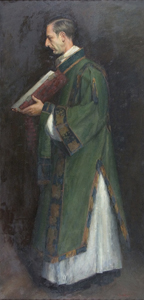
Wheelwright, John Brooks (1897-1940)
Role: poet, friend of BrownDates: 1897-1940
Portrait Location: Library-Annex
Artist: Thayer, Polly (1904 - 2006)
Portrait Date:
Medium: oil on canvas
Dimensions:
Framed Dimensions:
Brown Portrait Number: 289
Brown Historical Property Number: 0
Poet John Brooks Wheelwright's fusion of modernist aesthetics and Marxist politics formed the core of his active and influential literary and political career throughout the 1920s and 1930s. His poetry appeared in three volumes, Rock and Shell (1933), Mirrors of Venus (1938) and Political Self-Portrait (1940). John Ashberry later named Wheelwright's Collected Poems (1972) in the Sunday New York Times Book Review as one of the hundred most important books of Western literature since the end of World War II. According to John Malcolm Brinnin, had Wheelwright lived long enough to continue his career "he would very likely share rank and status with his close contemporaries Allan Tate, e. e. Cummings, and Hart Crane."
Wheelwright's poetry reflects the influence of his politics, his New England upbringing, and his religious conversion from Unitarian to Anglican. He helped found the Trotskyist Socialist Workers Party in 1937, just three years before his premature death in 1940 at age forty-three, when he was struck and killed by a drunken driver. Wheelwright was also active in the League for Cultural Freedom and Socialism, an organization of revolutionary writers in the United States inspired by a manifesto signed by Trotsky, surrealist author Andre Breton, and painter Diego Rivera.
According to Wheelwright scholar Alan M. Wald, by the end of his career Wheelwright �blended socialist political activity with poetic creativity to a degree unequaled in American literature." In 1936, Wheelwright explained to the painter Fairfield Porter, "So far as your career goes, consider it your chief contribution to the causes and no moral conflict will arise. A conflict must have arisen to have painting and socialism present a choice in your mind. Be a socialist painter, as another is a socialist cook, mechanic, lemon picker, or as with Engels, manufacturer."
Wheelwright prepared for college at St. George's School in Newport, Rhode Island. He studied at Harvard from 1916-1920, when he was expelled during his senior year for spotty attendance. He was an active member of the Harvard Aesthetes along with such renowned writers as John Dos Passos (1896-1970) and e.e. Cummings (1894-1962). Throughout his literary career he remained active in Boston literary circles. After leaving Harvard, he studied architecture at the Massachusetts Institute of Technology.
Born in Boston on September 9, 1897, Wheelwright has been called a "Boston Brahmin." His family genealogy can be traced back to the Massachusetts Bay Colony which banished his American ancestors in the mid 1600s for preaching religious tolerance. His mother, Elizabeth Brooks (Bessie) Wheelwright, a remarkable deaf woman noted for her lip reading skills and aristocratic bearing, was the great-granddaughter of Peter Chardon Brooks, the wealthiest of Boston's colonial "merchant princes," and John Taylor Brooks, one of Massachusetts' first governors. The mystique of the Brooks family was rendered so vivid to young Wheelwright by his mother that, as a teenager, he went to court to have his middle name changed to Brooks.
Wheelwright's father was the renowned architect Edmund March Wheelwright. The city architect of the City of Boston from 1891 to 1895, Edmund March Wheelwright trained at the Ecole des Beaux Arts in Paris. His work includes the Harvard Lampoon Building, The Longfellow Bridge, and Jordan Hall. In 1910 he had a mental breakdown and in 1912, when John Brooks Wheelwright was a teenager, his father committed suicide. Following this traumatic experience, John Brooks Wheelwright converted from Unitarianism to Anglicanism. Until his differences with official church dogma became too persistent to ignore, Wheelwright even pledged to become a priest. The poems in Political Self-Portrait (1940) contain insights into his gradual abandonment of Christianity aligned with his increased political passions. In the early morning of September 13 1940, at the intersection of Massachusetts Avenue and Beacon Street in Boston's Back Bay, Wheelwright died after being struck by a drunken driver. The poet Kenneth Rexroth later wrote that "Dead in his prime like so many other American poets, he was not like most of them, already burned out. No one has ever taken the place of this dynamic, inexhaustible and lovable mind and completely original talent."
Wheelwright�s connection to Brown was through his sister Louise Wheelwright Damon, who married Brown University Professor of English Samuel Foster Damon (1893-1971), and who is represented in the Brown portrait collection by her pencil drawing of her brother (BP 221) and by her oil painting of her husband (BP 220). Samuel Foster Damon was a distinguished writer, teacher, who, along with Robert Hillyer (1895-1961) published Eight More Harvard Poets. One of the eight poets included was John Brooks Wheelwright. Wheelwright�s papers were donated to the Brown University library by Louise Wheelwright Damon.
Polly Thayer�s portrait of John Brooks Wheelwright as a vested subdeacon of the Church of the Advent is undated, but appears to date from the mid 1930s, when she worked at the Fenway Studios in Boston and when Wheelwright embraced the idea of becoming an Episcopal priest. The unusually attenuated proportions of her portrait can be explained by the recent discovery that the painting was subsequentially reduced in width from its original size. Brown University�s correspondence with Polly Thayer�s biographer Dorothy Koval reveals that the painting originally included a second figure or crucifier looming in the background to the right, bearing a large cross. The daughter of Ezra Thayer, dean of the Harvard Law School, Polly Thayer traveled in the same social circles as Wheelwright and undoubtedly would have known his family. She was reported by her biographer to have been �quite distressed by the disfiguring of the painting,� which she believed had been cut down and overpainted by Louise Wheelwright Damon.
